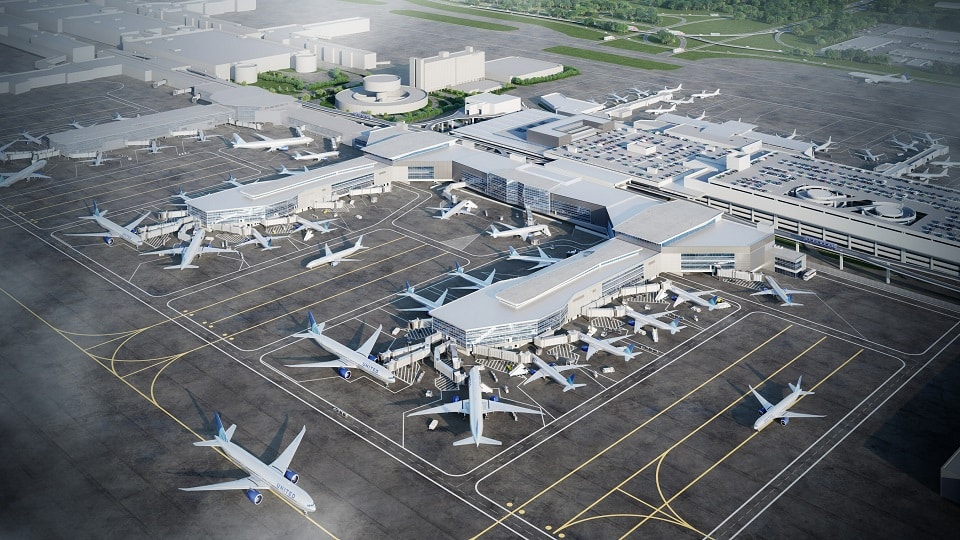Airlines
United Airlines, to Invest more than $2B in Terminal B Transformation

United Airlines and the Houston Airport System announced the Terminal B Transformation Programme, a landmark investment in United’s hub at George Bush Intercontinental Airport (IAH).
This ambitious project aims to redefine air travel and meet the needs of an estimated 36 million passengers in the future. The programme includes the construction of 40 new domestic and international gates, ensuring that travelers have a cutting-edge experience.
Travellers will discover new conveniences and amenities throughout their airport experience. The Terminal B transformation includes expanding curbside and roadway capacity, as well as expanding the ticketing lobby and providing passengers with convenience through dynamic signage, intuitive wayfinding systems, and a ground-level check-in area. The third floor will most likely house a streamlined security processing area.
Terminal B South Concourse converting 30 gates
The Terminal B South Concourse project entails converting 30 gates, which currently house smaller, 50-seat regional jets, into larger, two-class regional jets. All flights will be boarded via jet bridge, as opposed to the current terminal.
The Terminal B Transformation Programme is expected to cost more than $1.9 billion, according to United Airlines, and $624 million is expected to be provided by the City of Houston for enabling projects. The Houston City Council authorized and approved a Memorandum of Agreement between the City of Houston and United Airlines on Wednesday, November 15, 2023. The City of Houston plans to present requests for the appropriation of funds in multiple tranches over the project’s duration to the City Council for approval.
Construction and design
The IAH Terminal B Transformation Program, spearheaded by the seasoned Program Management team at AvAirPros and STV, comprises three pivotal components:
- The Terminal B arrival and departure hall is designed by Page, a full-service design, architecture and engineering firm based in Houston; and Grimshaw Architects, a London-based architectural firm and will be constructed by Clark Construction.
- The Terminal B Concourses were designed by PGAL, a Houston-based international design firm specializing in architecture, interiors, and engineering, and to be built by Manhattan Construction, a Houston-based company.
- The Baggage Handling System, will be designed by Siemens’, employing their expertise in the design and construction of these highly technical systems.

Airlines
Sanctions & Engine Issues Ground Half of Russia’s A320neo fleet

Russia’s aviation sector, already strained by Western sanctions, faces another setback as nearly half of its Airbus A320neo family aircraft are grounded due to unresolved engine issues.
This development highlights the growing challenges for russia commercial aircraft in maintaining their fleets under the weight of global restrictions and limited access to spare parts.
Out of the 66 Airbus A320neo and A321neo jets in Russia, 34 are now out of service, according to the Kommersant business newspaper. These planes are powered by engines manufactured by Pratt & Whitney, a subsidiary of RTX Corporation.
DAMAC Air: Dubai’s New Luxury Airline Offers Free Flights for Registration
The engines are affected by a previously identified defect in the metal used for certain parts, prompting accelerated inspections and maintenance.
Sanctions have compounded the issue, blocking the supply of essential components from major manufacturers like Boeing and Airbus. Without proper maintenance, experts warn that these aircraft may face decommissioning as early as 2026.
COMAC Unveils Plans for the C929 to Rival Airbus and Boeing
Airlines like S7, which operates a significant portion of these grounded jets, plan to conserve the engines for future use during peak travel seasons. However, reports suggest that over 20 of S7’s Airbus planes have engines that have already reached the end of their operational lifespan. Recently, russia seeks assistance from kazakhstan’s airlines to bolster its domestic flights.
While some A320neo and A321neo planes in Russia are equipped with French-made LEAP engines, which are seen as less problematic, the challenges remain daunting.
The situation underscores the long-term impact of sanctions on Russia’s aviation sector and the increasing difficulties in keeping its modern fleets operational.
-

 Aviation2 months ago
Aviation2 months agoMicrosoft Flight Simulator Raises $3 Million to Bring Back the An-225 Mriya
-

 Airlines2 months ago
Airlines2 months agoQantas Engineers Stage Walkout Over Cost of Living Concerns
-

 Airlines2 months ago
Airlines2 months agoQatar Citizens Can Travel to the United States Without a Visa
-

 Aviation2 months ago
Aviation2 months agoQatar Airways bans these new Electronic Devices on plane
-

 Airlines2 months ago
Airlines2 months agoJapan Airlines Rolls Out Free Domestic Flights to International Passengers
-

 Defence2 months ago
Defence2 months agoWhich Country Has the Largest Fleet of Fighter Aircraft?
-

 Airport2 months ago
Airport2 months agoWestern Sydney Airport Welcomes Its First Plane After 6 Years of construction
-

 Aviation2 months ago
Aviation2 months agoDid you know ? Once Boeing 747 carried 1088 passenger in 1991








